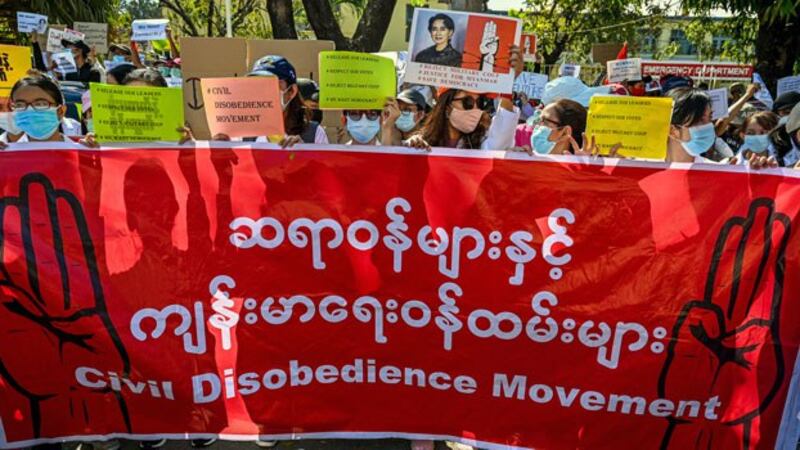The recording and reporting of COVID-19 cases in Myanmar has become spotty and case monitoring has been halted under the junta regime as growing numbers of medical personnel join the civil disobedience movement, doctors told RFA Friday.
Public concern about the coronavirus is nearly nonexistent now as anti-regime protests and violence by security forces have consumed the country for over a month since the Feb. 1 military takeover.
Information from COVID-19 test labs that operate under the Ministry of Health and Sports indicates that as of Feb. 1, the day the military seized power from the government, more than 2.4 million of Myanmar’s 54 million people had been tested for the highly contagious virus, and 142,000 had been confirmed positive.
The ministry’s last update showed that between Feb. 1 and Feb. 23 its labs tested 94,747 samples. Of those tests, 1,638 were positive, while 66 patients died, and 6,346 patients were discharged from hospitals.
But medical professionals are questioning the credibility of the latest COVID-19-related figures which have dropped significantly since the coup.
“Now, everyone I know is questioning these figures,” said a doctor in charge of a fever clinic in Yangon. “As far as I know, the COVID-19 labs have stopped operating. The patients can get the test only at the General Hospital. The ministry hasn’t updated the latest figures on COVID-19 as much as before.”
RFA contacted health ministry officials for updates, but they either they did not respond or they declined to comment.
Another doctor, who asked not to be named, said he is concerned about a possible third wave of the virus emerging in Myanmar.
“The COVID-19 outbreaks will not be gone completely. They will emerge as a third wave,” he said.
“It could be disastrous because the staffs of many government departments are now participating in the civil disobedience movement [CDM],” he said, adding that only medical personnel from military hospitals were still working in the field.
The doctor also expressed concern over the lack of updated COVID-19 counts by the Health Ministry.
“I haven’t seen the COVID-19 statistics updated by the Health Ministry for a long time,” he said. “The numbers are down, but I don’t know if it is because the people have gained more immunity or if the labs have stopped operating.”

‘Coup has ruined everything’
A physician participating in the CDM said that the country hasn’t seen the last of COVID-19.
“I don’t think COVID-19 is gone,” he told RFA. “There could be even more infections these days. The staff from the National Health Laboratory is now on strike in the CDM, so they cannot test the samples and trace the infections. That’s why the numbers are down.”
He said that health professionals have been waiting to see if military-trained lab technicians will resume testing the samples.
“But so far, they haven’t done anything,” the doctor said. “It is very worrying in terms of [another] COVID-19 outbreak in Myanmar.”
Myanmar reported its first case of COVID-19 on March 23 when the first wave began. During that time there were fewer than 400 confirmed cases and six deaths, with the last local transmission found in mid-July.
A second and more extensive wave began on Aug. 16 in western Myanmar’s Rakhine state, during which there was a dramatic increase in the number of cases compared to the first wave.
Under the former civilian government, doctors and medical personnel worked painstakingly to contain the virus outbreak and to vaccinate people once the shots became available in January, the physician said.
“But this military coup has ruined everything,” he said. “If it hadn’t disrupted this, we already would have vaccinated a large segment of the population.”
“The military regime is worse than COVID-19,” he added. “So, we doctors are all participating in the civil disobedience movement to get rid of the military regime. Once it is over, we will go back to treating patients.”
Repo rted by Mya Thae Khine RFA’s Myanmar Service. Translated by Ye Kaung Myint Maung. Written in English by Roseanne Gerin.

